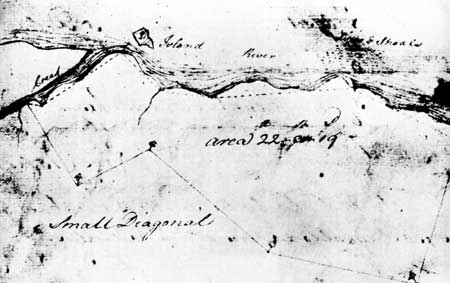|
GEORGE WASHINGTON BIRTHPLACE National Monument |
 |

Survey of Bridges Creek area by George Washington
at the age of 15.
George Washington
On February 11 (Old Style), 1732—when jasmine and jonquils were beginning to bloom and dark purple berries were forming on the native "cedar" trees—Mary Ball Washington gave birth to her first child, a boy she named George. The time was about 10 o'clock in the morning. At a later date the event was recorded with brevity in the family Bible:
George Washington son to Augustine & Mary his Wife was Born ye 11th Day of February 1731 / 2 about 10 in the Morning & was Baptis'd the 5th of April following Mr. Beverley Whiting & Capt Christopher Brookes godfathers and Mrs. Mildred Gregory godmother.
The date, "11th Day of February," was "Old Style." By the Gregorian calendar, adopted by Great Britain in 1752 and now in use in the United States, the date was February 22, 1732, "New Style."
The place where George was baptized on the 5th of April is unknown, although the christening probably took place in the Popes Creek home. If not there, it may have occurred at Mattox Church (located at Church Point about 2-1/2 miles away) or at Round Hill Church about 16 miles from the Popes Creek home by road. The Reverend Roderick McCullough was the minister in charge of the Episcopal churches in Washington Parish in 1732, but of his actual administering of the rite there is no record.
Very little is known about the godparents. A Beverley Whiting served as a burgess from Gloucester County, and a Christopher Brooke was captain of a Virginia ship, the Cambridge, but there is no evidence that these men were the ones, with similar names, recorded in the family Bible. The godmother, Mildred Washington Gregory, was George's aunt.
The first 3-1/2 years of George's life were spent at the Popes Creek plantation. At some unknown date between March 25 and November 18, 1735, Augustine Washington moved his family up the Potomac River about 50 miles to his farm on Hunting Creek (known today as Mount Vernon). Three years later Augustine purchased a 288-acre farm near Fredericksburg, and about December 1, 1738 (when George was almost 7 years old) moved there with his family.
In 1742 Augustine acquired another tract of land between Popes Creek and Bridges Creek—within sight of the home where George was born. With the exception of one piece of property on the river all of the Popes Creek-Bridges Creek peninsula was now owned by George's father.
In 1743, a few weeks after George's 11th birthday, Augustine Washington was stricken with a stomach disorder, and died on the 12th of April. He was interred in the family burying ground at Bridges Creek, where his father, Lawrence, and grandfather, John, were buried. Augustine left the Popes Creek-Bridges Creek plantation to his second son and namesake, Augustine, Jr. (one of George's elder half brothers).
After his father's death it appears that George resided variously with his mother on her farm near Fredericksburg; at Mount Vernon with another half brother, Lawrence; at "Chotank" in King George County with other relatives; and at his birth home on Popes Creek with his elder half brother, Augustine, Jr.
The frequency and length of these visits of George to Popes Creek are not known, but there is ample evidence that he stayed with his elder brother and sister-in-law on many occasions for long periods. During such visits he must have become familiar with every nook and cranny in his birth home, as well as with its outdoor attractions—the green fields of tobacco, corn, and wheat; the sweet-scented herb garden; the domestic animals, and other aspects of farm life beloved by all boys fortunate enough to know them.

A copy of a chain, compass, and scale drawn by
George Washington when he was 14 years old.
Beyond the cultivated fields grew the dense forest, which only a century before had been the hunting ground of the Indians. The dominant trees in the majestic woods were the broadleaf species—oak, maple, walnut, hickory, chestnut, holly, dogwood, persimmon, and tulip-poplar—interspersed with a few conifers, including cedar and several species of pine. Wild animals were abundant and young George probably hunted deer, bear, turkey, and other woodland creatures.
Tranquil Popes Creek must have had a special appeal to the growing boy, for along its edge, ducks and wild geese searched for food, and in its waters swam large turtles and many kinds of fish. More inviting than the creek, however, was the broad Potomac River—an invitation to fish, swim, and sail boat.
All was not play at the Popes Creek plantation. For when George visited his elder brother he undoubtedly helped with the numerous farm chores. Then, too, he may have attended the school Henry Williams conducted near Mattox Creek, although no direct evidence of this has been found. There is, however, reliable evidence that he mastered his first lessons in surveying while visiting his birthplace, for an existing survey of the Bridges Creek area was made by George in 1747, when he was only 15 years old.
It is not known when George left the Popes Creek plantation for the last time as a youth, but he must have departed with a touch of sadness. The joys and pleasures of life on such a busy and beautiful tidewater plantation must have been unforgettable to the tall, teenage boy.


|
|
Last Modified: Mon, Jan 20 2003 10:00:00 pm PDT |


